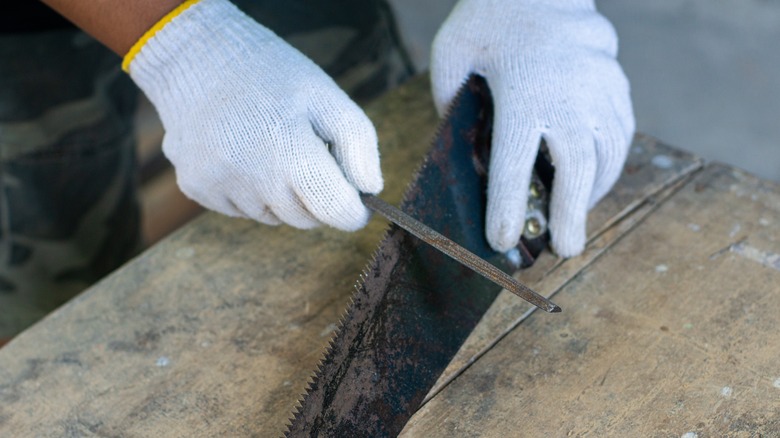The Best Method For Sharpening Your Hand Saw
A good hand saw is a joy to use. They're surprisingly efficient, accurate, versatile, and even incorporate a handy angle guide which helps save you time. But as with any blade, the teeth of a hand saw eventually wear down and need to be resharpened, or the saw must be replaced. If you don't like waste, then sharpening is the obvious answer. However, before looking at the best method to do that, it's important to know whether or not it's actually possible.
Hacksaws are a type of hand saw used for cutting metal. They have thin blades with very small teeth. Not only are they almost impossible to sharpen, but blade replacements are usually under $2 each, so they are treated as disposable. Some cheap hand saws for wood can also be a problem. Their teeth are made of hardened steel. You may see an obvious join where they were welded on, and they usually look darker than the rest of the blade. These teeth stay sharp for a long time, but when they do eventually wear, they cannot be resharpened.
A high-quality, woodworking hand saw usually has a blade and teeth that are all the same metal. They cost a little more, but because you can sharpen them, they will last for years. There's a freehand method to sharpen a hand saw, but the best, and safer, method requires a file, plus a vise and lumber strips.
Sharpening good hand saws is quick and easy
You can do this freehand, but it's safer to have a vise, two thin strips of lumber, and a small triangular file. Before you start, take a rag and some mineral spirits, and carefully remove any dirt or sticky residue. Next, sandwich the blade between the strips of lumber and clamp them in the vise with the teeth pointing upwards. Leave the teeth plus about ¼ inch of the blade protruding. Try to keep it all level. The wood strips prevent damage from the vise and stop unpleasant vibrations as you work.
Check the teeth. They will either be in a straight line (rip-cut) or every other tooth will be offset left and right (cross-cut). If it's a rip-cut blade, file directly across the front of each tooth, keeping the file as horizontal as possible. This shouldn't be hard work. Three or four light strokes per tooth should do. Push the file, don't pull it. If the saw is cross-cut, the file should be angled at 45 degrees to the blade. Check the angle of the first tooth, give it a few strokes, then repeat for alternate teeth along the blade. When you get to the end, turn the blade around and sharpen the teeth you missed. That's it.
A well-sharpened hand saw should be able to cut through any wood, plastic, or metal with very little effort. Now you know how it's done, your DIY life will be a lot easier!

